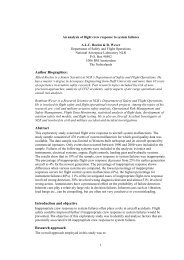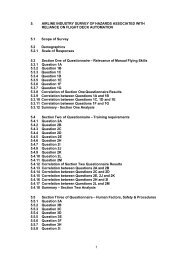Causal risk models of air transport - NLR-ATSI
Causal risk models of air transport - NLR-ATSI
Causal risk models of air transport - NLR-ATSI
You also want an ePaper? Increase the reach of your titles
YUMPU automatically turns print PDFs into web optimized ePapers that Google loves.
Notice also that P(A|C) does not necessarily imply that A is the effect and C is the cause.<br />
Take the example A = car does not start, C = empty fuel tank. Both P(A|C) and P(C|A)<br />
exist. In order to be able to differentiate between cause and effect there must be additional<br />
information on the direction <strong>of</strong> the relation between C and A. In a causal model this<br />
direction is indicated by a directed edge (see section 3.7).<br />
3.3. Causation to predict the future<br />
One <strong>of</strong> the main reasons why we are interested in causation is because it allows us to<br />
predict system behaviour if we assume that the past and present determine the future.<br />
Among the first scientists to seriously address this issue were the German philosopher<br />
Immanuel Kant (1724-1804) and the French mathematician Pierre Simon Laplace (1749-<br />
1827). Kant stated that every effect has a cause which is a prior event and that this cause<br />
effect relation is ‘fixed’. Therefore, if we have observed, in the past, that certain causes<br />
have certain effects we can assume that the same causes will have the same effects in the<br />
future [Kant 1781]. Laplace went even further when he published his theory <strong>of</strong> scientific<br />
determinism. He wrote [Laplace 1814]:<br />
"We may regard the present state <strong>of</strong> the universe as the effect <strong>of</strong> its past and the cause<br />
<strong>of</strong> its future. An intellect which at any given moment knew all <strong>of</strong> the forces that animate<br />
nature and the mutual positions <strong>of</strong> the beings that compose it, if this intellect were vast<br />
enough to submit the data to analysis, could condense into a single formula the<br />
movement <strong>of</strong> the greatest bodies <strong>of</strong> the universe and that <strong>of</strong> the lightest atom; for such<br />
an intellect nothing could be uncertain and the future just like the past would be<br />
present before its eyes."<br />
According to Laplace’s conception <strong>of</strong> nature, all laws in nature are deterministic, and<br />
randomness surfaces merely due to our ignorance <strong>of</strong> the underlying boundary conditions<br />
[Pearl 2000b]. Werner Heisenberg‘s (1901-1976) uncertainty principle shows that Laplace's<br />
vision, <strong>of</strong> a complete prediction <strong>of</strong> the future, cannot be realised (although Albert Einstein<br />
(1879-1955) did not agree with Heisenberg, because, according to Einstein, “God does not<br />
play dice with the universe”). According to Heisenberg’s principle, effects do not follow<br />
causes in a rigorous chain <strong>of</strong> events [Feynman 1965]. Nevertheless, we assume that to a<br />
very good approximation the laws <strong>of</strong> science behave deterministically. The problem then<br />
becomes one <strong>of</strong> complexity, there are simply too many variables (or in Laplace’s words,<br />
too many forces and beings that compose nature) to encompass. Because <strong>of</strong> this, all theories<br />
and <strong>models</strong> are approximations and we use probabilities to express the resulting<br />
uncertainty 12 . Apparent stochastic behaviour is then introduced in our deterministic view <strong>of</strong><br />
the world as a result <strong>of</strong> our approximations. Each approximation introduces an error term<br />
with respect to the ‘true’ value. The error propagates when numerical operations with other<br />
uncertain quantities are being conducted. Under some conditions the error term may grow<br />
disproportionately fast. Prigogine [1977] introduced the concept <strong>of</strong> bifurcation points.<br />
According to this theory a system which has bifurcations will imply both deterministic and<br />
probabilistic elements. In between two bifurcation points the system behaves<br />
deterministically, but in the neighbourhood <strong>of</strong> the bifurcation points fluctuations play an<br />
essential role and determine the ‘branch’ that the system will follow. The outcome <strong>of</strong> the<br />
model will then be increasingly uncertain when more cause effect relations are called upon,<br />
typically when predictions further into the future are made. Rapid error accumulation may<br />
12<br />
De Finetti (1906-1985) stated that probability is an expression <strong>of</strong> the observer’s view <strong>of</strong><br />
the world and has no existence <strong>of</strong> its own – probability does not exist (quoted by Lindley<br />
[1986]).<br />
27




